Multifeed
Multifeed - a device for receiving signals from multiple satellites on one antenna.
The surface of the satellite dish as a mirror reflects the signal from a satellite and focuses it in a certain place called focus.
As quite often happens that a few satellites inetersuyuschimi your programs are far from each other, it becomes possible to assemble the device, which can accommodate some converters next to the focus of the antenna, at the points of focus signals of these satellites
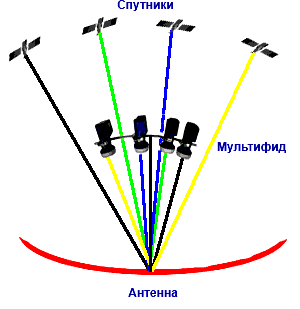
Figure 1 Principle of multifeed
Figure 1 shows that the signal from the satellite to a converter in accordance with the laws of reflection. When we set up the antenna on one satellite, you have a converter like the focus of the antenna, and dish, respectively, we look directly at the satellite. There is also a zone and the maximum signal level. But if we have a plate big enough, and the nearby satellites are quite acceptable for the signal power in our area, we can in accordance with a scheme to try to locate close to the main converter by others, and to receive signals from satellites of interest to us. In most cases, you should configure the central LNB on a satellite with the weakest signal. But in each case is to decide separately. For example, in central Europe is the weakest satellite to view the Russian-language television - Amos, but it is usually properties of the edge multifeed. because it is the least interesting of the others taken at multifeed three satellites - Sirius Hotbirda. Asters and is located on the extreme position.
To determine the possible signal reception enough to pick up a converter with cables connected to it, to enter into the receiver parameters of the most powerful transpordera, located on the satellite, and gently moving the converter in place to be a secondary focus is to try to catch the signal. It should be guided by such rules: The satellite signal is located to the left of the main will be taken in the area located to the right, if you look at multifeed is behind the plates, as shown in Figure 1, and vice versa. Also the signal from the satellite located above the orbit will be made below, and vice versa. It may be that the converter you will not even look at the center of the plates and rotated around the horizontal axis. After you place niluchshego reception can begin to assemble multifeed, ie attachment for additional converter. There may be various options, depending on in which Ku-band or C signals are transmitted at what distance are from each other converters, etc.
Those who wish to calculate the theoretical location of the converters can use the formula proposed by J. Forfun and published on the forum "Byvaly Maker. There you can clarify for myself and many other strange moments of the construction multifeed
Shift converters in multifeed both horizontally and vertically, can be accurately calculated on the assumption that the angle of incidence equals the angle of reflection:
A = F x sin | a |,
where F - focal length, | a | - module azimuth difference and elevation angles
WARNING !!!!!
To offset antennas in the formula for F must not expose the focal distance, and distance from the converter to the center offset more've seen it here
For those who have sufficient access to the antenna, enough empirically to find the best position of the converter at multifeed, moreover, that the specific characteristics of some Chinese dishes especially intended for reception in the C range is often quite different from the characteristics stated in the data sheet, and multifeed calculated by the formula may not provide sufficient reception quality. 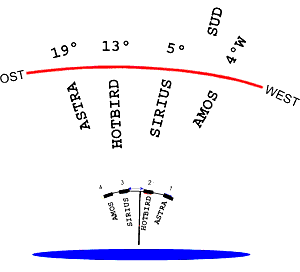
Construction multifeed for receiving Russian TV in Western Europe 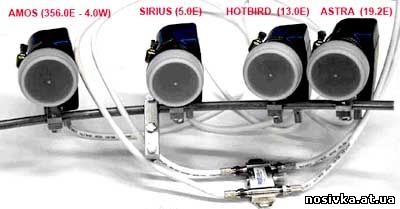
In Western Siberia, the construction multifeed are complex, as transpordery taken from different satellites are located in the upper Ku-band and in the lower C. The task is complicated not only by the fact that the converters have different sizes and hence have to create their own attachment to them, but so that the configuration of a satellite in C band harder than Ku, since the signal is in this range is more susceptible to a variety of industrial noise, and converters with the range it is important to correctly position the polarizer and the reflector, which is not always an easy task for China's cheap heads
Construction multifeed and recommendations for setup for the reception of television in Western Siberia on information from the website: www.sputnik-tv.com/
To view the channels from satellites Yamal, Ekspess-11, Express-6A, and the LMI must make multifeed. Once assembled, it looks like the photo. Multifeed installed in pryamofokusnuyu dish SVEC, China. The quality on all channels using Receiver Topfild-4000Fi 98-99%.
First, set up a central head on Yamal. It's no big deal, and maximize the signal on all transponders. Then catch the satellite Express 6A, there would have trouble, because the patched on weak transponder most interesting channels.
Ekspress11 caught very easily, because The satellite signal is very powerful, and customize virtually anything not necessary.
With head LMI have the most trouble, because must be very precise position to pick up, not knocking the settings of other heads. 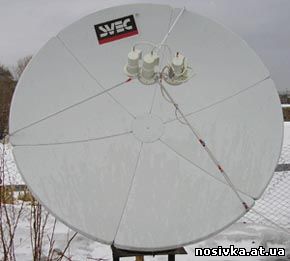

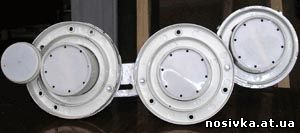
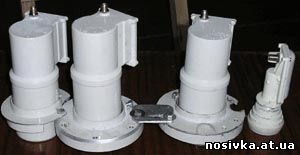
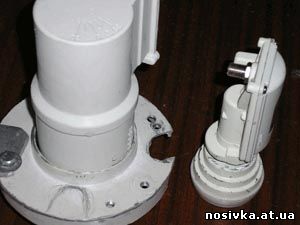
Once you have compiled and configured multifeed need converters to connect to the receiver. For Option 2 to 4 converters used Switches DiSEqC, which switch converters, depending on which channel you choose when watching TV on the receiver. To learn more about the principle of a switch you filter can learn here
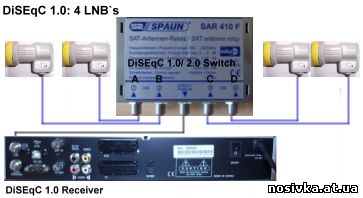
Connect 4 LNBs to the receiver.
With options to connect a larger number of converters can be found here
Next in the setup menu receiver to the number or names of satellites aligned with the order to connect the corresponding outputs of the converters to switch. Sometimes it happens that some converters do not work consistently with some types of switches. In this case you should try to connect the other converters, or purchase a higher quality switch, providing a good enough outcome. For example, the German switches "Spaun" practically free from these shortcomings, but their value is high enough.
Aucun commentaire:
Enregistrer un commentaire